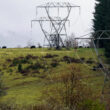Life for a community, like it often is for us as individuals, tends to ebb and flow.
We have high points: a commendation from the boss at work with a nice bonus, a wedding that promises to result in a good marriage, a new baby; and lows: a death of a loved one, illness, etc.
Similarly, as a community, we enjoy pluses: the completion of a new school or other useful public facility, an Oregon Jamboree that ends solidly in the black, a state athletic title; and minuses: another empty storefront on Main Street, the death of a leading citizen, too many Oregon Jamborees finishing too far in the red, etc.
Sweet Home is a unique community, attested as such by many besides ourselves.
The degree of community commitment here is significant, testified to by examples we’ve trumpeted before on this page: a Community Center built by the people who live here because they needed it; a median strip down the main drag that turns heads and garners regular appreciative letters to the editor from people who don’t live here; community improvement programs of all kinds operated by people who don’t stand to gain anything except the awareness that they’re meeting a need; etc. etc. We would be negligent not to add that the Oregon Jamboree, with the immense financial benefits it brings to the community outside of the actual balance sheet of the event itself, is largely the result of local volunteerism.
It’s rare to find a community that doesn’t have service of this sort, but Sweet Home stands out in the volume of volunteerism we have. But even here, the reservoir is limited.
This has been noted by those involved in the Livability Initiative, which holds out the potential for all sorts of help in making Sweet Home a more inviting, livable community. We are one of four (count ‘em) communities nationwide to be awarded this free study, which has resulted in a 160-page report that assesses Sweet Home’s economic, transportation, housing, health and employment situation and makes numerous recommendations of actions community residents could take to improve things.
The onus is on us, now, though to do something with it. The fact that we were selected to participate in this makes us, to put it bluntly, a good candidate for federal grants in the areas mentioned.
The problem is that the loyal cadre of people who engineered our selection for this assessment are mostly employed in demanding jobs, who are involved in other service and who are getting – not to put too fine a point on it – older and more tired with passing years.
The good news is that we’re seeing younger people beginning to realize that there’s a place for them, that they can contribute. And they’re beginning to step up. They’re serving on city and school district committees. They’re joining local service clubs. They’re taking leadership roles in organizations like the Sweet Home Community Foundation and the Oregon Jamboree.
We just need this. We need people with vision and energy to help figure out what Sweet Home should be when our kids grow up and help move the community toward that ideal. Does the idea of a recreational riverside trail linking Sweet Home and the existing Willamette National Forest resonate with us? There’s need for volunteers to make that happen, people who know how to work together, who can chennel the energy that’s out there, who want to make Sweet Home a better place.
We’ve mentioned examples of Sweet Home’s volunteer spirit and we’ve intentionally saved two of the best for last. Both are reflected in stories on page 1 of today’s issue.
Consider our Boys and Girls Club. Five months ago we reported that the Sweet Home branch was some $200,000 in the red, compared to Lebanon, due to lack of local community support. Local community members created a team of volunteers to research the problem and galvanize that needed support. We report in today’s issue that the final $27,000 of the $160,000 goal was raised in the final two weeks of June, thanks to some generous donors. That’s community spirit and the volunteerism that makes Sweet Home special.
But there’s more. The conversion of Husky Field to artificial turf is the result of a significant outpouring of community support in the form of heavy equipment, sweat and expertise. Local volunteers have spent weeks removing and trucking out more than a foot-deep layer of soil and replacing it with gravel and pipes in preparation for the final layer of artificial turf, which will provide an all-weather surface that, organizers say, will allow use year-round. Monday morning, 20 teenagers were out on the field in the hot sun, following directions, pounding nails and rolling hose.
The field is paid for. Local people decided it was important to have a place where kids could play year-round, not just when it’s dry. They paid the money to make it happen.
That’s what happens when Sweet Home decides to make something happen.




